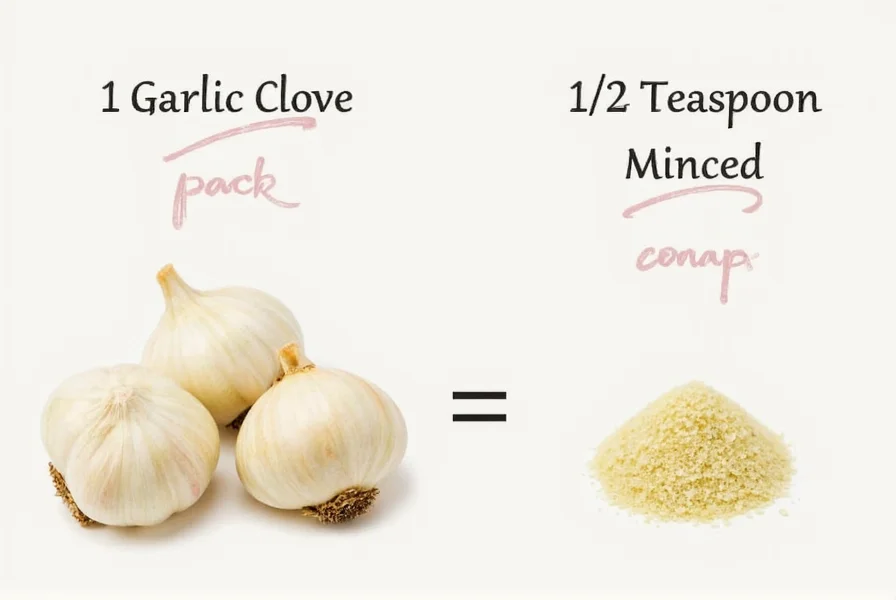Understanding garlic measurements is crucial for home cooks and professional chefs alike. When a recipe specifies “1 clove of garlic” but you only have pre-minced garlic, or vice versa, knowing the exact conversion ensures your dish turns out perfectly balanced.
Garlic Clove to Teaspoon Conversion Guide
The standard conversion most culinary experts agree upon is that one medium garlic clove equals about 1/2 teaspoon of minced garlic. However, garlic cloves vary significantly in size, which affects the precise measurement.
| Garlic Clove Size | Minced Garlic (Teaspoons) | Garlic Powder (Teaspoons) |
|---|---|---|
| Small (1/2" long) | 1/4 tsp | 1/8 tsp |
| Medium (1" long) | 1/2 tsp | 1/4 tsp |
| Large (1 1/4" long) | 3/4 tsp | 3/8 tsp |
| Extra Large (1 1/2" long) | 1 tsp | 1/2 tsp |
Factors Affecting Garlic Measurements
Several variables impact the precise conversion from whole cloves to teaspoons of minced garlic:
Garlic Clove Size Variations
Garlic bulbs contain cloves of different sizes. The outer cloves are typically larger than the inner ones. When recipes call for “one clove,” they usually mean a medium-sized clove unless specified otherwise. For how many tsp equals a clove of garlic calculations, always consider the actual size you're working with.
Preparation Method Matters
The way you prepare garlic affects volume:
- Minced garlic: Produces the most compact measurement (1 medium clove = 1/2 tsp)
- Pressed garlic: Yields slightly less volume due to moisture loss (1 medium clove = 3/8 tsp)
- Chopped garlic: Takes up more space (1 medium clove = 5/8 tsp)
Fresh vs. Pre-Minced Garlic
Many home cooks wonder about the garlic clove to teaspoon conversion when using jarred minced garlic. Bottled minced garlic contains preservatives and has a different moisture content. As a general rule:
- 1 fresh medium garlic clove = 1/2 teaspoon fresh minced garlic
- 1 fresh medium garlic clove = 3/4 teaspoon bottled minced garlic

Practical Cooking Applications
Knowing the exact how much minced garlic equals one clove conversion helps in multiple cooking scenarios:
When Precision Matters
For delicate dishes like aioli, mayonnaise-based sauces, or subtle-flavored soups, precise garlic measurements prevent overpowering the dish. In these cases, use the exact conversion: 1 medium clove = 1/2 tsp minced.
When Approximation Works
For heartier dishes like stews, roasts, or tomato sauces, garlic measurements can be more flexible. If you're unsure about how many teaspoons in one garlic clove, trust your senses—smell the garlic as you add it to gauge intensity.
Substitution Guide
Running out of fresh garlic? Here are reliable substitutions:
- 1 garlic clove = 1/8 teaspoon garlic powder
- 1 garlic clove = 1/2 teaspoon garlic paste
- 1 garlic clove = 1/2 teaspoon garlic-infused oil

Professional Chef Tips for Garlic Measurement
Top chefs recommend these practices for accurate garlic measurements:
- Minimize first, measure after: Mince your garlic before measuring for the most accurate teaspoon count
- Use a microplane: For the most consistent minced garlic texture that measures accurately
- Consider age: Older garlic cloves are drier and yield slightly less minced volume than fresh, plump cloves
- Don't pack it: When measuring minced garlic in a teaspoon, don't press it down—let it sit loosely for proper volume
Storing Minced Garlic for Future Use
If you frequently need to convert garlic measurement substitution chart values, consider pre-mincing and freezing garlic:
- Place 1/2 teaspoon portions (equivalent to one medium clove) in ice cube trays
- Cover with olive oil to prevent freezer burn
- Once frozen, transfer cubes to a labeled freezer bag
- Use directly from frozen in cooking—no need to thaw
This method ensures you always have the right cooking measurement conversion for garlic ready when needed, eliminating guesswork in your recipes.
Frequently Asked Questions
How many teaspoons of minced garlic equals two cloves?
Two medium garlic cloves equal approximately 1 teaspoon of minced garlic. For small cloves, use 3/4 teaspoon; for large cloves, use 1 1/2 teaspoons. This garlic clove to teaspoon conversion helps maintain proper flavor balance in recipes calling for multiple cloves.
Can I substitute garlic powder for fresh garlic cloves?
Yes, 1/8 teaspoon of garlic powder equals one medium garlic clove. Garlic powder has a more concentrated flavor than fresh garlic, so use less—about 1/3 the amount. This how much minced garlic equals one clove conversion applies to powder substitutions as well, though powder lacks the fresh moisture content.
Does the age of garlic affect the teaspoon measurement?
Yes, older garlic cloves dry out and shrink, yielding less minced volume than fresh cloves. A fresh medium clove produces about 1/2 teaspoon minced, while an older clove of the same size might only yield 3/8 teaspoon. Always consider garlic freshness when making how many tsp equals a clove of garlic calculations for precise recipes.
How do I measure garlic cloves without a teaspoon?
If you don't have measuring spoons, use visual references: one medium garlic clove minced should fill the tip of your index finger up to the first knuckle. For the garlic measurement substitution chart, remember that a standard playing card is approximately 2 inches by 3.5 inches—a 1/2 teaspoon of minced garlic would cover about one-quarter of a playing card.
Why does my bottled minced garlic taste different than fresh?
Bottled minced garlic contains citric acid and other preservatives that alter both flavor and texture. It's also more concentrated—use 3/4 teaspoon of bottled for every 1/2 teaspoon of fresh minced garlic (or one clove). This explains why the cooking measurement conversion for garlic differs between fresh and preserved forms.










 浙公网安备
33010002000092号
浙公网安备
33010002000092号 浙B2-20120091-4
浙B2-20120091-4